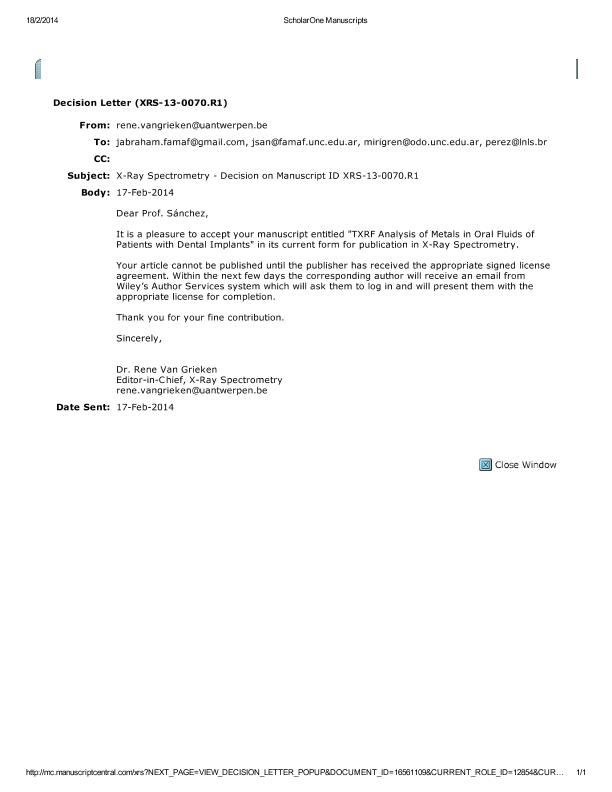Mostrar el registro sencillo del ítem
dc.contributor.author
Abraham, Jose A
dc.contributor.author
Sanchez, Hector Jorge

dc.contributor.author
Grenón, Miriam Silvina

dc.contributor.author
Perez, Carlos A.
dc.date.available
2017-12-28T17:34:23Z
dc.date.issued
2014-04
dc.identifier.citation
Abraham, Jose A; Sanchez, Hector Jorge; Grenón, Miriam Silvina; Perez, Carlos A.; TXRF analysis of metals in oral fluids of patients with dental implants; John Wiley & Sons Ltd; X-ray Spectrometry; 43; 4; 4-2014; 193-197
dc.identifier.issn
0049-8246
dc.identifier.uri
http://hdl.handle.net/11336/31824
dc.description.abstract
Corrosion of metals in implanted biomaterials lifetime is expected to occur. Nowadays, medical implants have good biocompatibility, present proper mechanical properties, and promote tissue regeneration; nevertheless, corrosion will eventually happen. Biological fluids are rich in chemically active ions; hence, electrochemical processes appear on the surface of the metal immediately after implantation. In order to evaluate corrosion resistance of metal implants, several studies have been carried out in artificial environments, but their results have not been always directly correlated to living systems. This work presents an indirect study of corrosion of dental implants by analyzing changes of elemental concentration of metals in oral fluids. It will also contribute to the knowledge of implant corrosion in relation to its biological environment. Degradation of the implant surface releases material to the medium, which, depending on the concentrations, can represent toxic risk, organic malfunction, pain, rejection, and so on. In order to evaluate this process, the concentrations of representative metals such as Ti, Al, and V in saliva and gingival fluids were analyzed by means of total reflection of X-rays fluorescence analysis using synchrotron radiation. The results obtained here show that Ti-ions present a different behavior in the oral fluids, revealing higher concentrations in gingival crevice fluid than in saliva. On the other hand, V and Al have not shown significant differences from normal levels in the oral fluids. Metal release is discussed under mechanical and chemical considerations, taking into account the oral environment of the implant.
dc.format
application/pdf
dc.language.iso
eng
dc.publisher
John Wiley & Sons Ltd

dc.rights
info:eu-repo/semantics/openAccess
dc.rights.uri
https://creativecommons.org/licenses/by-nc-sa/2.5/ar/
dc.subject
Titanio
dc.subject
Corrosion
dc.subject
Implant
dc.subject.classification
Otras Ciencias de la Salud

dc.subject.classification
Ciencias de la Salud

dc.subject.classification
CIENCIAS MÉDICAS Y DE LA SALUD

dc.title
TXRF analysis of metals in oral fluids of patients with dental implants
dc.type
info:eu-repo/semantics/article
dc.type
info:ar-repo/semantics/artículo
dc.type
info:eu-repo/semantics/publishedVersion
dc.date.updated
2017-12-26T20:39:25Z
dc.journal.volume
43
dc.journal.number
4
dc.journal.pagination
193-197
dc.journal.pais
Reino Unido

dc.journal.ciudad
Chichester
dc.description.fil
Fil: Abraham, Jose A. Universidad Nacional de Córdoba. Facultad de Matemática, Astronomía y Física; Argentina
dc.description.fil
Fil: Sanchez, Hector Jorge. Universidad Nacional de Córdoba. Facultad de Matemática, Astronomía y Física; Argentina. Consejo Nacional de Investigaciones Científicas y Técnicas; Argentina
dc.description.fil
Fil: Grenón, Miriam Silvina. Universidad Nacional de Cordoba. Facultad de Odontologia; Argentina. Consejo Nacional de Investigaciones Científicas y Técnicas; Argentina
dc.description.fil
Fil: Perez, Carlos A.. Laboratorio Nacional de Luz Sincrotron. Campinas; Brasil
dc.journal.title
X-ray Spectrometry

dc.relation.alternativeid
info:eu-repo/semantics/altIdentifier/doi/http://dx.doi.org/10.1002/xrs.2538
dc.relation.alternativeid
info:eu-repo/semantics/altIdentifier/url/http://onlinelibrary.wiley.com/doi/10.1002/xrs.2538/abstract
Archivos asociados
